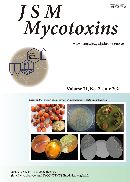
- Issue 2 Pages 51-
- Issue 1 Pages 3-
- |<
- <
- 1
- >
- >|
-
Kiyoshi Okano, Masakazu Ichinoe, Yuji Ozu, Haruo Takahashi2021Volume 71Issue 2 Pages 51-57
Published: July 31, 2021
Released on J-STAGE: August 07, 2021
Advance online publication: June 30, 2021JOURNAL FREE ACCESSPeanuts are one of the most susceptible crops to aflatoxigenic fungi, such as Aspergillus flavus and Aspergillus parasiticus, and is often contaminated with aflatoxins (AFs). AF contamination of peanuts is a major human and animal health hazard that has an economic impact worldwide. Numerous control and management strategies have been developed to reduce the levels of AFs in peanuts and sorting is the final stage in the process targeted at decreasing AF levels. Previous studies have shown that handpicking and electric color sorting are not entirely effective in reducing AF levels because of the occurrence of apparently healthy but internally moldy kernels with high AF levels. A previous study (Hirano, et al. 1998) showed that near infrared (NIR), the ratio of transmittance energies at two wavelengths of 700 to 1100, was applicable for efficiently removing internally moldy kernels. However the use of this procedure was limited to a sample that contained artificially inoculated kernels and low levels of AFs. This present study evaluated the performance of spectrometric sorting in naturally and highly AF-contaminated peanut lots on a commercial scale. The NIR spectrometric sorting clearly showed that AFs could be effectively decreased to levels of < 10 μg/kg even when the lot was highly contaminated with > 700 μg/kg of AFs by rejecting deteriorated kennels, including those that were internally moldy.
View full abstractDownload PDF (1210K)
-
Miho Kawanishi, Yusuke Kitani, Takayoshi Shinoda2021Volume 71Issue 2 Pages 59-62
Published: July 31, 2021
Released on J-STAGE: August 07, 2021
Advance online publication: June 15, 2021JOURNAL FREE ACCESSRecent reports have demonstrated that the deoxynivalenol (DON) mycotoxin produced by Fusarium sp. is metabolized to deoxynivalenol-3-glucoside (DON-3G) by glycosidation enzymes in infected plants, and subsequently DON-3G accumulates in the plant body. Although DON-3G is less toxic than DON, it is converted back to DON upon release in the intestinal tract of an animal. This reformed DON exhibits the same toxicity as DON initially produced by Fusarium. Thus, testing should be extended to DON-3G and other important mycotoxins. This study aimed to evaluate an analytical method based on liquid chromatography with tandem mass spectrometry (LC-MS/MS) for the detection and quantification of DON, acetyl forms of DON (3-Ac-DON, 15-Ac-DON), a glycoside form of DON (DON-3G), and another Fusarium mycotoxins such as nivalenol (NIV), 4-Ac-NIV, T-2 toxin (T-2), HT-2 toxin (HT-2), zearalenone (ZEA), and diacetoxyscirpenol (DAS) in wheat and barley. The method was validated using wheat and barley samples spiked with each mycotoxin at levels of 0.01 and 0.1 mg/kg. The average recovery of mycotoxins in wheat and barley ranged from 77.4% to 110.3% with a relative standard deviation of 2.2% to 15.7%. These findings demonstrated that this LC-MS/MS method is reliable for the analysis of Fusarium mycotoxins, including the acetyl and glycoside forms of DON, in wheat and barley. All parameters corresponding to the trueness, repeatability, and reproducibility as intermediate precision satisfied the criteria values.
View full abstractDownload PDF (443K) -
Abdelrahman Elamin, Shohei Sakuda2021Volume 71Issue 2 Pages 63-67
Published: July 31, 2021
Released on J-STAGE: August 07, 2021
JOURNAL FREE ACCESSAflatoxin contamination in medicinal herbs raises a big concern. The susceptibility of Ziziphus jujuba var. spinosa fruit to aflatoxin contamination and infection of aflatoxigenic fungus was evaluated based on ripening stages and fruit parts. Fruits or their parts at different ripening stages, contaminated with aflatoxin by inoculating Aspergillus flavus, were used for investigating the relationship of aflatoxin contamination with ripening stages, fruit parts, and fungal mycelial growth by aflatoxin analysis and microscopic study. The results showed 1) the intermediate ripening stages were highly susceptible to aflatoxin contamination, 2) when each fruit part was inoculated with A. flavus, aflatoxin concentration in the seed part was highest among the fruit parts, and 3) the hilar region is the area of the fungal mycelial penetration within the seed. This study suggests that it is better to store the fruits in a ripe and intact state for preventing aflatoxin contamination during storage.
View full abstractDownload PDF (1305K)
-
Tomoya Yoshinari2021Volume 71Issue 2 Pages 75-78
Published: July 31, 2021
Released on J-STAGE: August 07, 2021
Advance online publication: April 21, 2021JOURNAL FREE ACCESSMycotoxins are toxic compounds that are naturally produced by certain types of fungi. In order to reduce the daily intake of mycotoxins which contaminate foods and harm human health, many countries have established regulatory limits for mycotoxins. In Japan, aflatoxins, including aflatoxin M1, deoxynivalenol and patulin in food are regulated in 2020. In this proceedings, regulatory limits and analytical methods for these mycotoxins were presented.
View full abstractDownload PDF (1264K) -
Akira Furukawa, Mikiko Hayashi, Yukiko Yamada2021Volume 71Issue 2 Pages 79-91
Published: July 31, 2021
Released on J-STAGE: August 07, 2021
Advance online publication: June 15, 2021JOURNAL FREE ACCESSCereal grains such as corn and milo, most of which are imported, are primary livestock feeds in Japan. The climatic condition of the exporting countries, among other factors, may have impact on the concentrations of mycotoxins in these cereals, which may adversely affects health of both livestock and human.
This paper introduced an overview of the risk management by the MAFF regarding mycotoxins in livestock feeds, including the method to establish reference values in line with the internationally adopted rule, and offering a real example on establishment of the reference value for fumonisin B1+B2+B3 in compound feed.
View full abstractDownload PDF (2469K)
-
2021Volume 71Issue 2 Pages 95
Published: July 31, 2021
Released on J-STAGE: August 07, 2021
JOURNAL FREE ACCESSDownload PDF (488K)
- |<
- <
- 1
- >
- >|